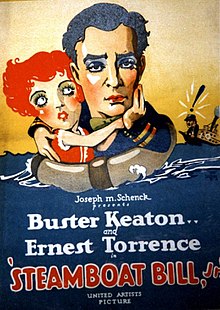| Steamboat Bill, Jr. | |
|---|---|
 Theatrical poster | |
| Directed by |
|
| Screenplay by |
|
| Story by | Carl Harbaugh |
| Produced by | Joseph M. Schenck |
| Starring | Buster Keaton |
| Cinematography |
|
| Edited by | Sherman Kell (uncredited) |
| Distributed by | United Artists |
Release date |
|
Running time | 70 minutes (8 reels) |
| Country | United States |
| Languages | Silent film English intertitles |
Steamboat Bill, Jr. is a 1928 silent comedy film starring Buster Keaton. Released by United Artists, the film is the final product of Keaton's independent production team and set of gag writers.
The film was not a box-office success and became the last picture Keaton made for United Artists. Keaton ended up moving to Metro-Goldwyn-Mayer, where he made one last film in his trademark style, The Cameraman, and Spite Marriage, before his creative control was taken away by the studio.
Charles Reisner directed the film, and the credited story writer was Carl Harbaugh. The film, named after Arthur Collins's popular 1911 recording of the 1910 song "Steamboat Bill," also featured Ernest Torrence, Marion Byron, and Tom Lewis. The film is known for what may be Keaton's most famous film stunt: The facade of a house falls around him while he stands in the precise location of an open window to avoid being flattened.
In 2016, the film was selected for preservation in the United States National Film Registry by the Library of Congress. The copyright of the film expired in 1956.[a]
Cite error: There are <ref group=lower-alpha> tags or {{efn}} templates on this page, but the references will not show without a {{reflist|group=lower-alpha}} template or {{notelist}} template (see the help page).